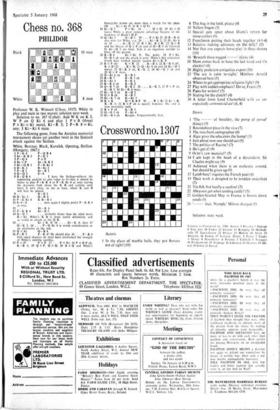Chess no. 368
PHILIDOR
Black White
10 men
8 men
Professor W. K. Wimsatt (Chess, 1937). White to play and mate in two moves; solution next week. Solution to no. 367 (Cohn): Add W K on K 5, W P on Q Kt 6 and play 1 P x B (threat P x Kt = Kt mate), Kt - R 3; 2 P- R 8 = Kt, any; 3 Kt - Kt 6 mate.
The following game, from the Asztalos memorial tournament shows yet another twist in the San3isch attack against the Sicilian.
White, Barczay. Black, Kavalek. Opening, Sicilian. (Hungary, 1967.) 1 P- K 4 P- Q B 4 2 Kt-K B 3 P-Q 3 3 P - Q 4 PxP 4 Kt x P Kt - K B 3 5 Kt-Q B 3 P-K Kt 3 6 B - K 3 B - Kt 2 7 P - B 3 Kt - B 3 8 Q - Q 2 0 - 0 9 B- Q B 4 . . . t have the feeling—without the supporting analysis to give value to it—that it should be better to play P - K R 4 or P -K Kt 4 at once leaving the decisions both about the K B and castling until later; it isn't clear, to me at least, where K and B will best be placed. 9 . . B - Q 2 10 B -1(t 3 Q - R 4 II P-K Kt 4 K R-B I
12 0-0- 0 . . . here again I slightly prefer P - K R 4 at once.
12 . . . Kt - K 4 13 P - K R 4 Kt -B 5 14 Q - Q 3 . . . probably better than the older move B x Kt. White's K B is more useful defensively and as useful in attack as the Q B. 14 . . . Kt x B. If 14 . . . Kt - K 4; then 15 Q - K 2. 14 . . . P - Q Kt 4 is worth consideration as an alternative to the text. 15 Q X Kt Q - B 4
16 P -R 5 P - K 4? He should play 16 . P - R 4 with equal chances; he must have overlooked the strength of White's coming sacrifice.
17 P x P! PxP 17 ..PxKt; 18 PXBPch, K -B 1; 19 Q x P. X Q; 20 R x Q and White's
formidable pawns are more than a match for the piece (20. . . Kt x Kt P; 21 R x Q P), 18 Kt -B 5 P x Kt 18 . . . Q x Q; 19 Kt x Q leases White a great endgame advantage because of the weakness of Black's Q P.
19 Q -Kt 5 Q -B 7. 19 . . P et Kt P; 20 R -R 6! also wins for White, e.g. 20 .. . Kt - R 2: 21 Q- Kt 6 or 20 . . . K-B 1; 21 R x Kt, B x R; 22 Q x B and the threats of Q x P ch and of Q - R 8 ch followed by Kt- Q 5 are fatal. Text is an ingenious attempt to force off the queens.
20 R -R 6 Kt x Kt P. The point. 21 P X Kt, Q -B 5 ch and the attack is gone. White's fine refutation would have worked equally against Kt x K P.
21 B X P ch! K X B 21 . . . K -B I; 22 R - R 8 chi. K X B (22 . . B x R; 23 Q-Kt 8 ch and 24 Kt -Q 5 mate); 23 Q - R 5 ch, K -K 2; 24 Kt - Q 5 ch and
25 Q X P mate.
22 Q -Kt 6 eh K - B I 23 R - R 7 B - R 3 ch
24 K - Kt 1 B - K 1 25 R - R 8 ch K - K 2
26 Q - R 7 ch B - B 2 26 . . . K -K 3; 27 P x P ch.
K -B 3; 28 Kt - K 4 mate.
27 Kt - Q 5 ch K - Q 2 28QxBeh K - B 3 29 Kt - K 7 ch K - Kt 3
30RxR QxKBP 30...RxR; 31 Kt x12. K - R 3; 32 R X P ch is equally hopeless. The cnd is now mercifully swift. 31 R X P ch K - R 5 32 Q - Q 5 ch P - Kt 4
33 Kt - B 6 ch Resigns. Unquestionably best.


































 Previous page
Previous page